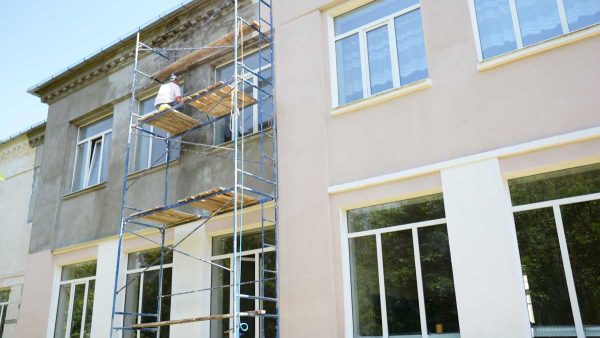Restoring EIFS and stucco walls

When restoring EIFS, stucco, and concrete masonry exterior structures, the approach can vary based on the extent of wear, tear, or damage. Restoring the value and appearance of a property requires careful analysis and a structured plan. There are four levels of restoration to consider, ranging from basic cleaning to extensive recladding.
Clean and recoat: a surface-level solution
The first level of restoration focuses on aesthetic improvement by removing dirt, stains, mold, or mildew. The goal is to refresh the facade’s color and appearance. Achieving this requires a careful water-cleaning solution combined with a pressure washer, ideally operating at 1200 psi or less. This ensures the removal of contaminants without harming the existing surface. By the end of this phase, the exterior should be spotless and ready for recoating, presenting a revitalized look to any onlooker.
Repair and finish: addressing minor damages
Minor damages, if left unaddressed, can escalate into significant issues. Level two restoration is about identifying and rectifying these early-stage problems. Whether it’s impact damage to EIFS, water penetration, or compromised stucco integrity, a level two restoration addresses these concerns. This phase might include applying a basecoat, mesh, and finish. The primary aim is to restore the wall’s water-shedding capabilities, ensuring the building remains dry and damage-free.
Overclad: refacing the wall
A level three restoration is in order when the cladding fails to keep water at bay or when aesthetic or energy efficiency demands are high. This level is about more than repair; it’s a significant overhaul. The overclad material choices vary, from EIFS and stucco to masonry, block, or stone substrates. Especially in instances of damage from natural causes, recladding is essential to protect the building from moisture and potential structural harm.
Remove and reclad: complete restoration
Level four is reserved for extreme cases. When the damage is extensive and the walls have suffered significant moisture damage, a total revamp is in order. This step involves stripping away the existing exterior cladding and replacing it. The goal of a level four restoration is not just repair but the incorporation of the five key elements of “the perfect wall.” These elements are vapor retarders, air barriers, water penetration barriers, thermal barriers, and water-shedding surfaces. Such an approach ensures longevity, safety, and enhanced aesthetics.
Restoring the value and functionality of a property, especially one with EIFS, stucco, or concrete masonry exteriors, requires a strategic approach. By understanding the four levels of restoration, property owners can make informed decisions on the best course of action, ensuring their building’s longevity, aesthetic appeal, and overall structural health.
